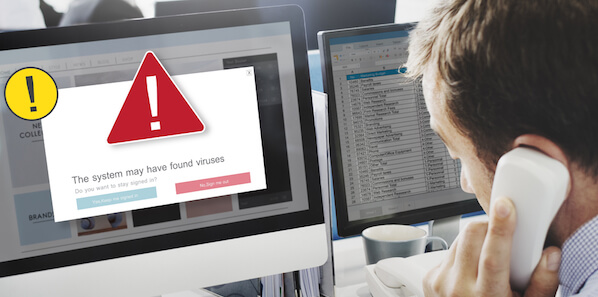Viruses, phishing scams, and spam are annoying on your personal computer. They can tap into your contacts, siphon off important information from bank accounts and credit card numbers, and be downright embarrassing when “you” email everyone you know about discount sunglasses or a bank account in the West Indies. But annoying quickly turns to catastrophe when it’s your business involved.
Here’s what you need to know to stay protected.
What’s the Difference Between a Virus and a Phishing Scam?
Often we use these terms for predatory actions interchangeably. After all, bad is bad when it comes to cyber security, right? But, be aware, there are some subtle differences.
A computer virus is designed to go from computer to computer and can replicate itself, which can be particularly devastating if it goes undiagnosed for a while. But its limitations lie in the fact that it cannot do these things without programming. Most of the time the programming is instituted through user error by opening an infected file, document, or clicking on a URL.
A virus may often lay dormant until something sets it off, like running an infected program. Once it infects your computer, it will spread to the entire computer network if left unchecked. Viruses can do some different things from skimming passwords to e-mailing your contacts, from installing a new toolbar to watching your every keystroke.
A phishing scam, on the other hand, is designed to gain information such as credit card numbers or bank accounts. A popular one currently looks like it comes from Amazon. It tells the opener that their account was breached and that “Amazon” has to verify the account. Then it asks for account information. Whether it’s Amazon, FedEx, Yahoo, UPS, or any number of large companies, these companies have your account information. They will never send you an email asking you for it.
Both viruses and phishing scams require a vehicle to infiltrate your system. That vehicle is a spam email. Think of spam email as a chameleon. Talented designers out there can make email from anywhere look like your favorite store or someone you do business with.
How Do You Protect Your Business from Viruses, Phishing Scams, and Spam?
Fortunately, it’s not difficult to protect yourself and your business. Most of it involves education and knowing what to look for. These tips will help.
- Never open emails from an unknown source, download anything, or click on a URL.
- Keep your virus software up-to-date, installing all patches and new versions as they come out. Do not put off updates.
- If you receive an unexpected email from a large company requesting something of you, especially if it’s about security issues, go directly to the company website. If it’s a security breach they’re contacting you about, you can bet there will be information on its website. Don’t go on branding alone. Graphic designers can make an email look an awful lot like the original company’s email and logo.
- Hover over any URL in an email before clicking it. If you hover over it, you can see where it’s going to take you. There is no reason an Amazon email, for instance, will be going to Amazonemailsecurity7z25e74@anyother.com.
- Look at the type of document and extension before every download. Some are notoriously suspicious like a .JS, .exe or, .shs. When in doubt contact your company’s tech department.
- Monitor your network constantly so that you can catch issues early and isolate them.
You won’t get a warning a virus or scam is coming. The only way to protect yourself is through preparation and education of things to avoid. In today’s world of bringing your own device and using the company network, it’s incredibly important that all of your employees understand the risks and the dangers.
If you’d like to know more about cyber security and avoiding viruses and phishing scams, contact CIO Tech today. Learn how managed IT services can help keep you protected.


